当今世界经济的三大支柱PPT课件
WTO世界贸易组织

世界贸易组织 (WTO)总部(日内瓦)
• 1.促进经济和贸易发展,以提高生活水平、 保证充分就业、保障实际收入和有效需求 的增长。
• 2.根据可持续发展的目标合理利用世界资 源、扩大商品生产和服务。
• 3.达成互惠互利的协议,大幅度削减和取 消关税及其他贸易壁垒并消除国际贸易中 的歧视待遇。
• 1.最惠国待遇原则 • 2.国民待遇原则 • 3.互惠互利原则 • 4.扩大市场准入原则 • 5.促进公平竞争与贸易原则 • 6.鼓励发展和经济改革原则 • 7.贸易政策法规透明度原则
•
机遇:
•
1.加入WTO要求中国按照国际游戏规则处理经济事务,将促进我国由计划
经济体制向市场经济体制的彻底转变。
•
2.加入WTO有利于我国金融体制的改革,使之更好的服务于市场经济和经
济结构的需要。
•
3.加入WTO要求政府对经济的管理和宏观调控更多的采取经济手段,将促
使政府职能的转变。
•
4.加入WTO有利于打破地区封锁和部门垄断,促使全国统一市场的开发。
•
7.加快实施国有经济布局的战略性重组。
• 最惠国待遇是贸易条约中的一项重要条款, 其涵义是:缔约一方现在和将来给予任何 第三方的一切特权、优惠和豁免,也同样 给予缔约对方。其基本要求是使缔约一方 在缔约另一方享有不低于任何第三方享有 或可能享有的待遇
• 权利:世贸组织所有成员提供的最惠国待 遇;直接参与国际多边贸易新规则的制定; 获得稳定、透明、可预见的多边贸易体制 的保障。
方一道,签署了实施乌拉圭回合多边贸易谈判结果的最后文件。鉴于 世界贸易组织的成立,中国表示希望成为世界贸易组织的创始成员国。 • 1995.1.1:WTO成立。7.l 日WTO决定接受中国为观察员。 • 1996.3.20:WTO中国工作组在日内瓦举行第1次会议。 • 2001年12月11日,中国正式成为世贸组织成员。
世界经济概论期末复习PPT教学课件
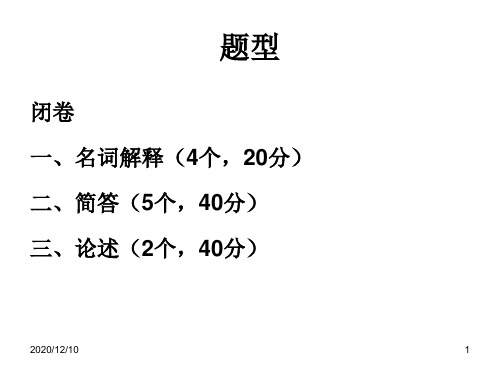
原因
美国是世界上最富强的国家, 占据了广阔的国际市场 大力发展科技教育,发展新兴 工业和军事工业; 改善人民生活,创造经济发展 环境
经济发展弊端显露;受到危机 严重打击 通货膨胀,债务沉重
改革社会经济; 加大发展教育科技事业的力度, 促进以信息产业为代表的高新 技术的发展 ; 完成传统产业的技术改造 14
第八章 巴西
1.金砖四国、金砖五国 2.巴西经济发展历程
16世纪初 —— 二战前
殖民初期,出口木材; 16世纪,种植甘蔗; 17世纪出口矿石; 1920世20/1纪2/10种植出口咖啡。
二战结束至今
改变单一的经济形式, 发展多种经济结构, 经济飞速发展,在世界 经济中居前10位之列。15
殖民地式经济
• 原因:
✓ 越战影响
✓ 石油危机
✓ 通货膨胀
2✓020债/12/1务0 沉重
9
ห้องสมุดไป่ตู้
2020/12/10
越战影响
• 越南战争耗资巨大 • 长期赤字财政的后
果开始显露,美国 的国际收支恶化 • 美元危机由此出现
10
石油危机
• 1973年10月,第四次 中东战争爆发引发
• 造成美国汽车工业下
降32%,股市大幅下
• 殖民母国:葡萄牙 • 经济形态:采矿业、种植业 • 特征:单一经济 • 影响: ➢ 双重剥削 ➢ 影响国家区域发展 ➢ 经济易受国际价格影响
2020/12/10
16
什么是单一经济?
• 单一经济是指一个国家的经济主要以生产 和出口一两种矿产或农产品为主。
• 这种经济结构主要是受到殖民者长期的殖 民统治和残酷剥削而产生的。
• 例如:德国
世界经济体制的“三大支柱”
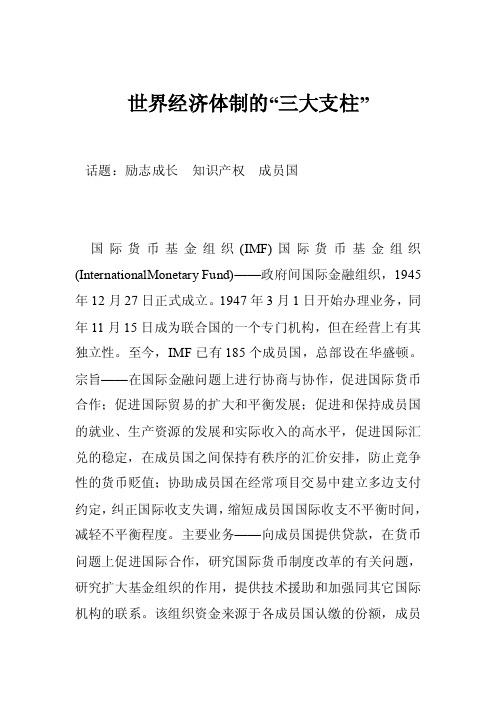
世界经济体制的“三大支柱”话题:励志成长知识产权成员国国际货币基金组织(IMF)国际货币基金组织(InternationalMonetary Fund)——政府间国际金融组织,1945年12月27日正式成立。
1947年3月1日开始办理业务,同年11月15日成为联合国的一个专门机构,但在经营上有其独立性。
至今,IMF已有185个成员国,总部设在华盛顿。
宗旨——在国际金融问题上进行协商与协作,促进国际货币合作;促进国际贸易的扩大和平衡发展;促进和保持成员国的就业、生产资源的发展和实际收入的高水平,促进国际汇兑的稳定,在成员国之间保持有秩序的汇价安排,防止竞争性的货币贬值;协助成员国在经常项目交易中建立多边支付约定,纠正国际收支失调,缩短成员国国际收支不平衡时间,减轻不平衡程度。
主要业务——向成员国提供贷款,在货币问题上促进国际合作,研究国际货币制度改革的有关问题,研究扩大基金组织的作用,提供技术援助和加强同其它国际机构的联系。
该组织资金来源于各成员国认缴的份额,成员享有提款权,即按所缴份额的一定比例借用外汇。
1969年创设“特别提款权”的货币(记账)单位,作为国际流通手段的一个补充,以缓解某些成员国的国际收入逆差。
成员国有义务提供经济资料,并在外汇政策和管理方面接受该组织的监督。
组织机构——最高权力机构为理事会,由各成员国派正、副理事各一名组成,一般由各国的财政部长或中央银行行长担任。
执行董事会负责日常工作,行使理事会委托的一切权力,由22名执行董事组成,其中6名由美、英、法、德、日、俄、中、沙特阿拉伯指派,其余16名执行董事分别由其他成员国组成的16个选区选举产生。
执行董事每2年选举一次。
总裁由执行董事会推选,负责基金组织业务工作,任期5年,可连任,另外还有三名副总裁。
中国是该组织创始国之一。
1980年4月17日,国际货币基金组织正式恢复中国代表权。
1991年,该组织在北京设立常驻代表处。
基金功能——(1)外汇资金融通。
世界经济体系讲解PPT(32张)

2.5 经济发展与经济增长
2.5.1 经济发展是一个多维结构
以经济增长为基础,包括经济增长、教育和 健康、生态环境、收入分配、生活质量 等多方面的内容
UN的人类发展指数(HDI)指标体系:
——GDP ——成人识字率 ——出生时预期寿命
2.5.2 增长与发展的关系
2.5.3 政策与发展 ——政府的经济政策对于经济发展的影响 ——政府职能和市场作用的配合
•
7、时间就像一张网,你撒在哪里,你的收获就在哪里。纽扣第一颗就扣错了,可你扣到最后一颗才பைடு நூலகம்现。有些事一开始就是错的,可只有到最后才不得不承认。
•
8、世上的事,只要肯用心去学,没有一件是太晚的。要始终保持敬畏之心,对阳光,对美,对痛楚。
•
9、别再去抱怨身边人善变,多懂一些道理,明白一些事理,毕竟每个人都是越活越现实。
•
3、大概是没有了当初那种毫无顾虑的勇气,才变成现在所谓成熟稳重的样子。
•
4、世界上只有想不通的人,没有走不通的路。将帅的坚强意志,就像城市主要街道汇集点上的方尖碑一样,在军事艺术中占有十分突出的地位。
•
5、世上最美好的事是:我已经长大,父母还未老;我有能力报答,父母仍然健康。
•
6、没什么可怕的,大家都一样,在试探中不断前行。
2.5.4 现代化 现代化是经济发展的成果和目标。
现代化是一个综合的、动态的发展过程。 人们衡量现代化的指标体系在不断变化, 更加强调以人为本,追求人的全面发展、 人与自然的和谐。
2.6 世界经济中的相互依赖
2.6.1相互依赖的内涵
世界经济中的相互依赖是指: 一个国家的经济发展取决于其他国家的发展和 政策;一个国家的发展和政策又影响到其他国
二战后世界经济体系
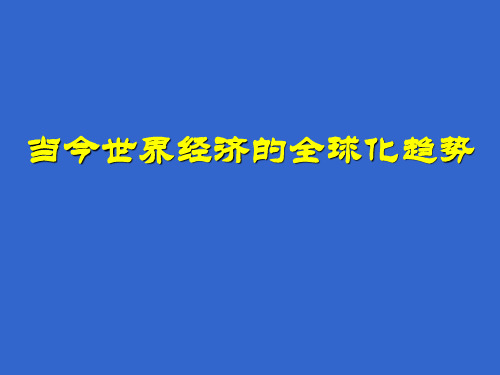
局限性:临时协定;协商,不具法律约束。 趋势:从无序到有序;从法律规则不严密到规范化、法制化; 从贸易保护到贸易相对自由。
分析关贸总协定的局限性。 归纳世界贸易的发展趋势。
体系构建,对比变化,认识升华
世界经济——制度化、体系化, 顺应全球化
启示: 开放 合作 协调 规则
二战后资本主义世界经济体系特点、作用? 制度化、体系化; 特点: 顺应全球化; 制度化、 经济发展; 体系化; 世界和平; 美主导; 扩张美霸权。
巩固练习: 1.2008年5月,我国西部数省遭受严重震灾,灾后重建任 务艰巨。中国如需要向国际社会寻求长期贷款和技术援 助,应该向下列哪一国际机构提出申请
A.WB
B.IMF
C .WTO
D.APEC
2.在2008年的全球金融风暴中,冰岛总理总理吉尔· 哈尔 德宣布,国家可能将要破产。为度过金融危机,冰岛已向 俄罗斯、欧盟寻求帮助,此外它还可能向下列哪一组织求 援?
意味着国际货币金融关系自20世纪30年代以来一直动荡不安的局面的终结 和新的国际货币金融格局的形成……《布雷顿森林协定》的许多规定均大大 有利于形成和维护美国在世界事务中的霸权地位,在这种意义上可以说,布 雷顿森林体系是维护美国霸权的重要机制。 ──洪国起等《人权•主权•霸权:透视美国人权外交》 惨痛的历史教训使人类在二战后进行了更大更深的调整。在国际政治领域, 出现了联合国;在国际经济领域,出现了制度性协调机制,这些在较大程度 上保障了二战后世界的整体和平。 ——《世界知识》2001年第8期
•二战后为什么能建立起新的经济体系?
结合教材知识链接和材料: 第二次世界大战期间,英国的海外贸易濒于停顿, 黄金储备几乎用竭。战争结束时英国债台高筑……昔日“大英帝国”称霸全球 的日子一去不复返了。 ——《20世纪的战争与和平》 主要资本主义国家工业生产所占比重(%)
世界经济体系讲解(ppt 32页)

马克思: 过去那种地方的和民族的自给自足和闭关自 守状态,被各民族的各方面的相互往来和各方面 的相互依赖所代替了。
相互依赖的实质是是世界范围的商品 经济的整体性
2.6.2 相互依赖的类型
——对称和均衡的依赖 ——不对称和不均衡的依赖
2.7 国际经济传递机制 ——商品、资本、技术、劳动力等实物形态 ——各国经济在波动和发展上的相互传递的 无形形态
2.2.1经济时间是世界经济发展的纵向尺度 形成了世界经济发展的历史过程
2.2.2经济空间是人类经济活动的空间范围 和空间尺度 人类经济活动的半径在增大
2.3 经济体
2.3.1 国家是经济活动的基本单元,也是世界 经济范畴中最基本的经济体
2.3.2 企业是向社会提供物质产品和服务 的基本组织
跨国公司
世界市场是世界经济有机体核心
2.5 经济发展与经济增长
2.5.1 经济发展是一个多维结构
以经济增长为基础,包括经济增长、教育和 健康、生态环境、收入分配、生活质量 等多方面的内容
UN的人类发展指数(HDI)指标体系:
——GDP ——成人识字率 ——出生时预期寿命
2.5.2 增长与发展的关系
2.5.3 政策与发展 ——的配合
2.3.3 家庭是天然的和最小的经济细胞
2.3.4 其它特殊区域或组织
2.4 经济活动与市场枢纽
2.4.1物质财富的社会生产、分配、交换和 消费以及建立在这一基础上的各种活动
国际化、全球化发展趋势
2.4.2市场枢纽
各种经济活动通过世界市场连接起来,形成 国际贸易、国际投资、其他国际经济合作
2.5.4 现代化 现代化是经济发展的成果和目标。
现代化是一个综合的、动态的发展过程。 人们衡量现代化的指标体系在不断变化, 更加强调以人为本,追求人的全面发展、 人与自然的和谐。
当今世界经济的全球化趋势ppt23 人民版
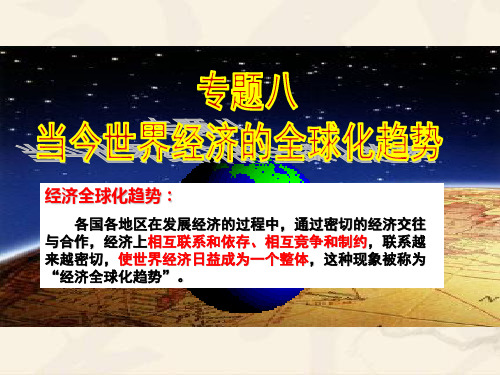
回顾展望——经济全球化的发展进程
新航路开辟、早期殖民扩张
第一次工业革命
商品输出
第二次工业革命
资本输出
“二战”后 资本新一轮的扩张
世界市场初具雏形 世界市场初步形成 世界市场最终形成
经济全球化时代
三、经济全球化的世界
当今世界用来调节世界经贸关系,推动经济 全球化发展的主要有哪三大国际经济机构?
探究二:经济区域集团化对世界经济发展的影响?
一方面,经济区域集团化有利于加强区域内各国经济的 联系,促进其发展;也有利于加强集团之间的经济联系和合 作;有利于世界多极化趋势。
另一方面,区域集团均具有排他性,在一定程度上又妨 碍了世界经济的发展;区域集团中的发展中国家主权和经济 安全受到一定程度的威胁。
(2)1995年1月1日,WTO正式成立;(与GATT并存一年)
(3)1996年1月1日,WTO正式取代GATT;
3、宗旨:
(1)市场开放(关税减让、透明原则等)
促进世
(2)非歧视性(最惠国待遇原则等)
界贸易
(3)公平贸易(反倾销原则等)
自由化
4、作用:
对经济全球化的影响(两个标志、两个表明) 教材158页
(二)关税与贸易总协定
——形成以美国为中心的资本主义世界贸易体系
(三)战后资本主义世界经济体系形成的认识
(1)美国在体系中拥有特殊地位; (主导地位) (2)体系顺应了经济全球化趋势; (3)反映战后世界经济向着体系化、制度化方向发展
小结升
世
华
战后资本主义世界经济体系
界 经
(以美国为中心)
济 朝
国际货币金融体系
延伸:IMF和WB在今天(美国影响力的日渐下降)
三大产业(2).ppt

党和国家历来十分重视农业、农村和农民民经济中的基础地 位,发展乡镇企业的重大意义以及切实减轻农民 负担等问题。本题具有深刻的现实意义。
审读本题,必须弄清:①“无农不稳”的“农” 是指第一产业,即广义的大农业,这句话在于强 调农业在整个国民经济中的基础地位,它的兴衰 成败事关全局。②“无工不富”的“工”不是作 为第二产业的工而是指广义农业中的乡镇企业。 广大农民正是主要依靠它才逐步走向富裕,它是 脱贫致富和实现农业现代化的必由之路。③农业 与乡镇企业是稳定和富裕的关系,二者是相互联 系、相互促进的。
(注:考生若能准确地指出:主要原因在于我国吸收外 资大于对外投资,则可加分。)
3。(2000年春季高考)材料一:1978年安徽凤阳小岗 村18户农民率先实行包干到户,揭开了以家庭联产承包 责任制为中心的农村经济体制改革的序幕。1984年中央 决定,农村土部承包期15年不变;1998年再次决定,土 地承包期再延长30年。
答案:(1)中央两次延长土地承包期,目的是要稳定完善 双层经营体制,关健是要稳定完善土地承包关系。以家庭承 包经营为基础、统分结合的双层经营体制,是我国农民的伟 大创造,它极大地解放和发展了我国农村生产力,有利于加 强我国农业的基础地位,有利于农村的稳定,乃至全国的稳 定。 (2)说明改革开放20千来,我国农村产业结构发生了 巨大变化:第一产业比重大幅度下降,第二产业和第三产业 的比重都有不同程度的提高,我国农村产业结构逐步趋向合 理。 (3)①由于家庭联产承包责任制的实行,极大地促进 了农村生产力的发展,推动我国农村产业结构发生了巨大变 化。 ②必须长期稳定以家庭承包经营为基础、统分结合的
经济发展三大支柱
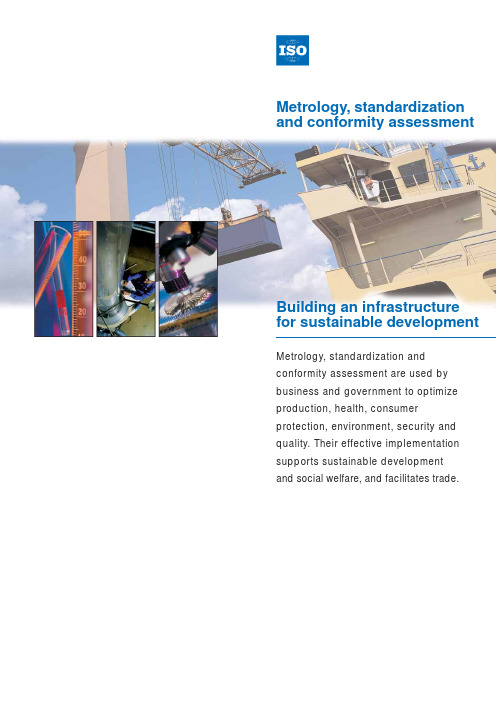
Metrology, standardization and conformity assessmentMetrology, standardization and conformity assessment are used by business and government to optimize production, health, consumer protection, environment, security and quality. Their effective implementation supports sustainable developmentand social welfare, and facilitates trade.Building an infrastructure for sustainable developmentThree pillars of sustainable development, 2006Metrology includes work by national measurement institutes and inter-national treaties such as the Metre Convention – which gives authority to the International Committee for Weights and Measures (CIPM) and the International Bureau of Weights and Measures (BIPM) to act on measure-ment standards of ever-increasing accuracy, range and diversity. Thereis a need to demonstrate equivalence between national measurement standards.The CIPM Mutual Recognition Arrangement provides governments and other parties with a secure technical foundation for wider agreements related to international trade, commerce and regulatory affairs. It helps to eliminate technical barriers to trade and instill greater confidence in the measurement capabilities of individual countries. The result is billions of dollars of increased trade.Legal metrology is coordinated by the International Organization of Legal Metrology (OIML). Legal metrol-ogy specifications are produced within the OIML and are adopted in all countries. The OIML also provides other valuable services such as a model law on metrol-ogy that can be used in setting up national technical infrastructure.International standards and their use in technical regulations on products, production methods and services play a vital role in sustainable development and trade facilitation – through the promo-tion of safety, quality and compatibility. The benefits derived are significant. Standardization contributes not only to international trade but also to the basic infrastructure that underpins society,including health and environment, while promoting sus-tainability and good regulatory practice.The leading organizations that produce International Standards are ISO, IEC and ITU. The scope of ISO covers standardization in all fields except electrical and electronic engineering, which are the responsibility of the IEC, and telecommunications covered by the ITU. The three organizations have a strong collaboration on standardization in the field of information technology. International standards, or national or regional adop-tions of international standards, help domestic markets to operate effectively, increase competitiveness and provide an excellent source of technology transfer to developing countries. They play an integral role in the protection of consumers and the environment.Developing countries face many trade-related standardization challenges. They require access to standardization infra-structure to engage in the global trading system. With the increasing globalization of markets, international standards (as opposed to regional or national standards) have become critical to the trading process, ensuring a level playing fi eld for exports, and ensuring imports meet internationally recognized levels of performance and safety.Standards can be broadly sub-divided into three categories: product , process and management systems . Product refers to the quality and safety of goods or services. Process refers to the conditions under which products and services are to be produced, packaged or refined. Management system standards help organizations to manage their operations. They are often used to create a framework within which an organization consistently achieves the requirements set out in product and process standards.The World Trade Organization Agreement on Technical Barriers to Trade (WTO/TBT) recognizes the contribution that international standardization can make to the transfer of technology from developed to developing countries, and the role of international standards and conformity assessment systems in improving the efficiency of pro-duction and in facilitating international trade.Three pillars of sustainable development :metrology, standardization and conformity assessmentstandardization pillarmetrology pillarEvery country needs a sound infrastructure to achieve its societal goals. At the most basic level, this means providing a plentiful supply of clean water and shelter. It means adequate internal transportation links, provi-sion of healthcare and an accessible education system. Beyond the basics, all societies wish to garner the benefits of the wider world of international trade. At the same time, they wish to be part of initiatives such as the United Nations Millennium Development Goals.As a result, there is an increasing awareness of the need to discuss, compare and improve infrastructures in the context of global economic efficiency, and market access for goods and services for both developed and developing countries. This is where metrology, standardization and conformity assessment come in. They are the pillars of knowledge for developing a technical infrastructure, and thereby enabling sustain-able development and full participation in international trade. And they are firmly linked together.Three pillars of sustainable development, 2006Building capacityThe t hree pillars described above are interdependent.Metrology and physical standards provide the basis for accurate measurements, the accepted performance of which can then be written in international standards, which can in turn be used as the basis for conformity assessment. But it is recognized that for many countries the cost of providing all these activities at their most advanced level is prohibitive. Even in the case of developed countries there are variations in the sophistication of each part of the technical infrastructure. In many cases some parts of the infrastructure may be jointly owned or shared by one or more countries. Sometimes, the services of another country are relied upon altogether.It is important for sustainable development and trade to ensure that societies and industries in developing coun-tries have access to a technical infrastructure that refl ects specifi c needs.Conformity assessment plays a critical role in building confidence for sustain-able development and trade.International Standard ISO/IEC 17000 defines conformity assessment as a “ d emonstration that specifi ed require-ments relating to a product, process, system, person or body are fulfi lled. ”Conformity assessment procedures, such as testing, inspec-tion and certifi cation, offer assurance that products fulfi l the requirements specifi ed in regulations and standards.Conformity assessment is specific to the object being assessed – it can be a product, a process or a management system – and to the body undertaking the assessment. For example, it may be the f irst party , such as the manufacturer of a product, which is making a supplier’s declaration of conformity using its own internal testing system or a third-party certification or inspection, undertaken by an independent service provider. The service provider could be a government agency or a private company.Each organization must decide which type of conform-ity assessment is necessary for which purpose. One of the crucial decisions is whether to make conformity assessment mandatory through government regulations in specific sectors, or whether to rely on the market to determine in a voluntary manner the conformity assess-ment requirements within normal transactions between buyers and sellers.This decision should be based on an assessment of the risks involved with a particular product or process, and on an understanding of the impact the associated costs and benefi ts will have on achieving sustainable develop-ment.Successive reviews of the WTO/TBT Agreement have noted the usefulness of ISO/IEC conformity assessment standards and guides in harmonizing conformity assessment practice and as benchmarks for the technical competence of assess-ment bodies, thus enhancing credibility and confi dence in their results. ISO/IEC’s conformity assessment work therefore helps to overcome technical trade barriers.Accreditation is the “ t hird-party attestation related to a con-formity assessment body conveying formal demonstration of its competence to carry out specifi c conformity assess-ment tasks” (ISO/IEC 17000). Establishing accreditation systems based on international standards and guides and linked with membership of the ILAC and/or IAF mutual recognition arrangements can help provide assurance to trading partners that suppliers of tests and certifi cates are competent. At the same time it helps in overcoming technical trade barriers and in complying with the require-ments of the WTO/TBT Agreement.conformity assessment pillar Any capacity-building efforts should be based on :• a thorough needs assessment for all parts of the econ-omy ;• the understanding that there is no ready-made model for technical infrastructure. Developing countries themselves must make policy decisions and provide an ongoing political commitment to those decisions ;• careful consideration of the assessed needs, based on the type and appropriate sequencing of assistance, to ensure the technical infrastructure is built in a sustain-able and planned manner ;• a clear articulation of the resources and fi nance that will be required to sustain the necessary technical infrastructure ;and • the fact that the development of a national technical infrastructure should not preclude consideration of bilateral or regional service delivery options that may achieve better economies of scale. The t hree pillars are vital for everyone. Provision of assist-ance aimed at strengthening the technical infrastructures of developing countries is necessary for sustainable devel-opment, and to enable developing countries to effectively participate in global trading.AcknowledgementThis publication is based on a paper entitled “Building corresponding technical infrastructures to support sustainable development and trade in developing countries and countries in transition” prepared by the Joint Committee on coordinationof assistance to developing countries in metrology, accreditation and standardization, JCDCMAS. The original document is available on . Members of the JCDCMAS are :•Bureau International des Poids et Mesures (BIPM)• International Accreditation Forum (IAF)• International Electrotechnical Commission (IEC)• International Laboratory Accreditation Co-operation (ILAC)•International Organization for Standardization (ISO)•International Trade Centre UNCTAD/WTO (ITC)•Telecommunication Standardization Bureau of ITU (ITU)•International Organization of Legal Metrology (OIML)•United Nations Industrial Development Organization (UNIDO)ISO Central SecretariatInternational Organization for Standardization1, rue de Varembé,Case postale 56CH-1211 Genève 20, SwitzerlandTel. + 41 22 749 01 11Fax + 41 22 733 34 30E-mail central@Web ISBN 92-67-10416-0•© ISO, 2006-02/3000。
国际经济体系的三大支柱──国际货币基金组织、世界银行及关贸总协定
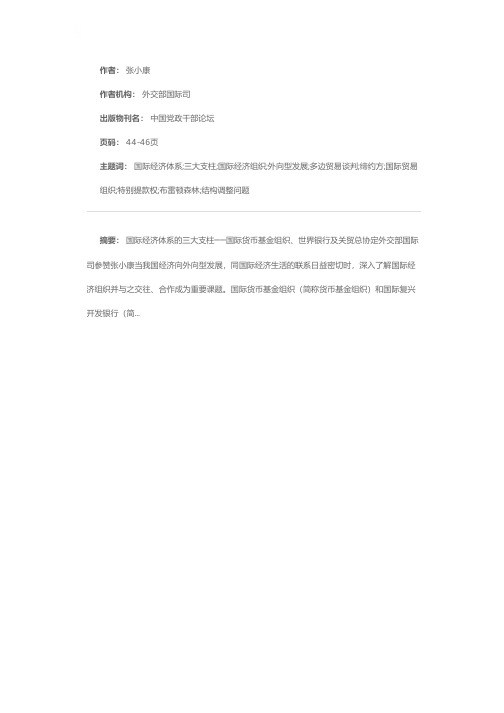
作者: 张小康
作者机构: 外交部国际司
出版物刊名: 中国党政干部论坛
页码: 44-46页
主题词: 国际经济体系;三大支柱;国际经济组织;外向型发展;多边贸易谈判;缔约方;国际贸易组织;特别提款权;布雷顿森林;结构调整问题
摘要: 国际经济体系的三大支柱──国际货币基金组织、世界银行及关贸总协定外交部国际司参赞张小康当我国经济向外向型发展,同国际经济生活的联系日益密切时,深入了解国际经济组织并与之交往、合作成为重要课题。
国际货币基金组织(简称货币基金组织)和国际复兴开发银行(简...。
- 1、下载文档前请自行甄别文档内容的完整性,平台不提供额外的编辑、内容补充、找答案等附加服务。
- 2、"仅部分预览"的文档,不可在线预览部分如存在完整性等问题,可反馈申请退款(可完整预览的文档不适用该条件!)。
- 3、如文档侵犯您的权益,请联系客服反馈,我们会尽快为您处理(人工客服工作时间:9:00-18:30)。
2001年4月23日,日本政府以进口激增对其国 内产业造成严重损害为由,对中国的大葱、鲜香 茹、蔺草席3种农产品实行200天紧急限制进口措 施,即上述农产品对日出口量若超出日方限定配 额数,其关税就得分别由现行的3%、4.3%、6%升 至256%、266%、106%。为了反对贸易保护主义,我 国政府宣布自6月22日起,对原产日本的汽车、空 调、手持或车载移动电话等几种工业品加争征 100%的特别关税。经中日双方多次磋商,中日双 方终于握手言和
2020年10月2日
3
世界贸易组织的目的是各成员国在互惠互利 的 基础上,削减 关税 ,消除国际贸易中的其 他贸易障碍 和 歧视待遇,推动实现世界贸易 自由 化 (中心目标),充分利用世界资源,扩大商品的 生产和交换,促进各成员国的经济发展 (最终目 标)。
2020年10月2日
4
各成员国的经济发展(最终目标)
汇报人:XXX 汇报日期:20XX年10月10日
17
2020年10月2日
1
当今世界经济的三大支柱
世界性贸易 与金融组织
世界贸易组织(WTO) 国际货币基金组织(IMF)
2020年10月2日
世界银行(World Bank)
2
世界贸易组织(WTO)是一个专门 协调国际贸易关系的 国际 经济 组织(性质),是 独立 于联合国的永久性 国际组织(地位),成立于 1995 年 1 月 1 日, 总部设在瑞士(首都)日内瓦 ,其前身是 关贸总协定 ,现 有 143 个成员,其经济贸易量占全球贸易总额的95%以 上(现状)。
(三)(1)在经济全球化的背景下,国 际贸易自由化是世界经济发展的总趋势,但 是贸易保护主义依然存在。我们必须采取符 合WTO规则的有效手段积极应付,保护自己的 利益。(2)企业要不断优化出口产品结构, 提高出口产品质量,增强出口产品在国际市 场上的竞争力。(3)实施市场多元化战略, 增加产品销售渠道。(4)政府部门应做好反 倾销的应对工作,开通信息渠道,建立预警 机制,帮助国内产业在国际贸易战中积极应 付,尽快成熟。
背景材料
2001年4月23日,日本政府以进口激增对 其国内产业造成严重损害为由,对中国的大 葱、鲜香茹、蔺草席3种农产品实行200天紧 急限制进口措施,即上述农产品对日出口量 若超出日方限定配额数,其关税就得分别由 现行的3%、4.3%、6%升至256%、266%、106%。 日本这一做法严重违背了世界贸易组织的自 由贸易原则。
演讲完毕,谢谢观看!
Thank you for reading! In order to facilitate learning and use, the content of this document can be modified, adjusted and printed at will after downloading. Welcome to download!
(二)日本对中国进口农产品征收高 额关税,归根到底是贸易保护主义作崇。 WTO规则既允许运用保护措施保护国内产 业,但也倡导维护公平竞争。日本对中国 发动贸易战,是一种不合理、不公正甚至 带有歧视性的单方面行为,违背了WTO的 基本原则,不仅损害了中国出口企业、生 产者的利益,而且也损害了日本进口企业 和消费者的利益。
1、海关是主权的象征。近代中国能否运用关 税保护民族经济?为什么?
2、日本对中国进口农产品征收高额关税,其 实质是什么?
3、加入WT国际贸易战,我们 应该如何应对?
(一)海关是民族经济的保护伞。1842 年中英《南京条约》规定英商进出口货物 缴纳的关税税率,中国须同英国商定,使 中国关税自主权开始遭到破坏。从19世纪 60年代开始,英国人赫德长期任中国海关 总税务司,使中国海关管理权落入外国人 之手。外国侵略者直接控制中国海关,便 利了他们对中国进行经济侵略,中国民族 经济失去了海关的保护。
2020年10月2日
7
世界贸易组织 在国际经济贸 易领域中发挥 着积极作用
它较大幅度地降低了了世界各地进口关税 的水 平,有利地促进了国际贸易的发展。
它规定了国际贸易中的各项基本原则 ,在 一定程度上促进了国际贸易的有秩序 进行。
2020年10月2日
它实施了一些有利于 发展中国家 的条款, 进一步促进了发展中国家的对外贸易 的发 展。
世界贸易自由化(中心目标)
互惠互利 世界贸易组织
目标
2020年10月2日
5
①材料道出了一个什么事实? ②为什么材料中特别举例1995年? ③世界贸易组织坚持降低进口关税有何重要意义?
2020年10月2日
6
世界贸易组织在处理国际贸易关系中, 实施的最重要原则是非歧视 原则。它推动了各 缔约国之间实行 无条件最惠国待遇 ,公平交易, 反对 贸易歧视 。
8
关贸总协定
1995年
世界贸易组织
1948年 1950年
中华民国
2020年10月2日
1986年
2001年 12月11日
中华人民共和国
9
有利于世界 经济
需要
有利于中国 经济
世界贸易组织
机遇“浪”
挑战 中 “狼” 国
理智的 欢迎
2020年10月2日
10
背景材料:
为限制中国打火机的进口,欧盟最近抛出 CR法规,CR法规的核心内容是,规定进口价在 两欧元以下的打火机必须设有防止儿童开启装 置即安全锁。这使得年产5亿多只、占世界市 场分额近70%的温州打火机,将面临推出欧洲 市场的危险。将价值与安全标准挂钩不尽合理, 违背了WTO非歧视性原则。据有关部门统计, 我国的出口企业中有一半以上遭遇过国外“技 术壁垒”,每年因此损失约数百亿美元。
